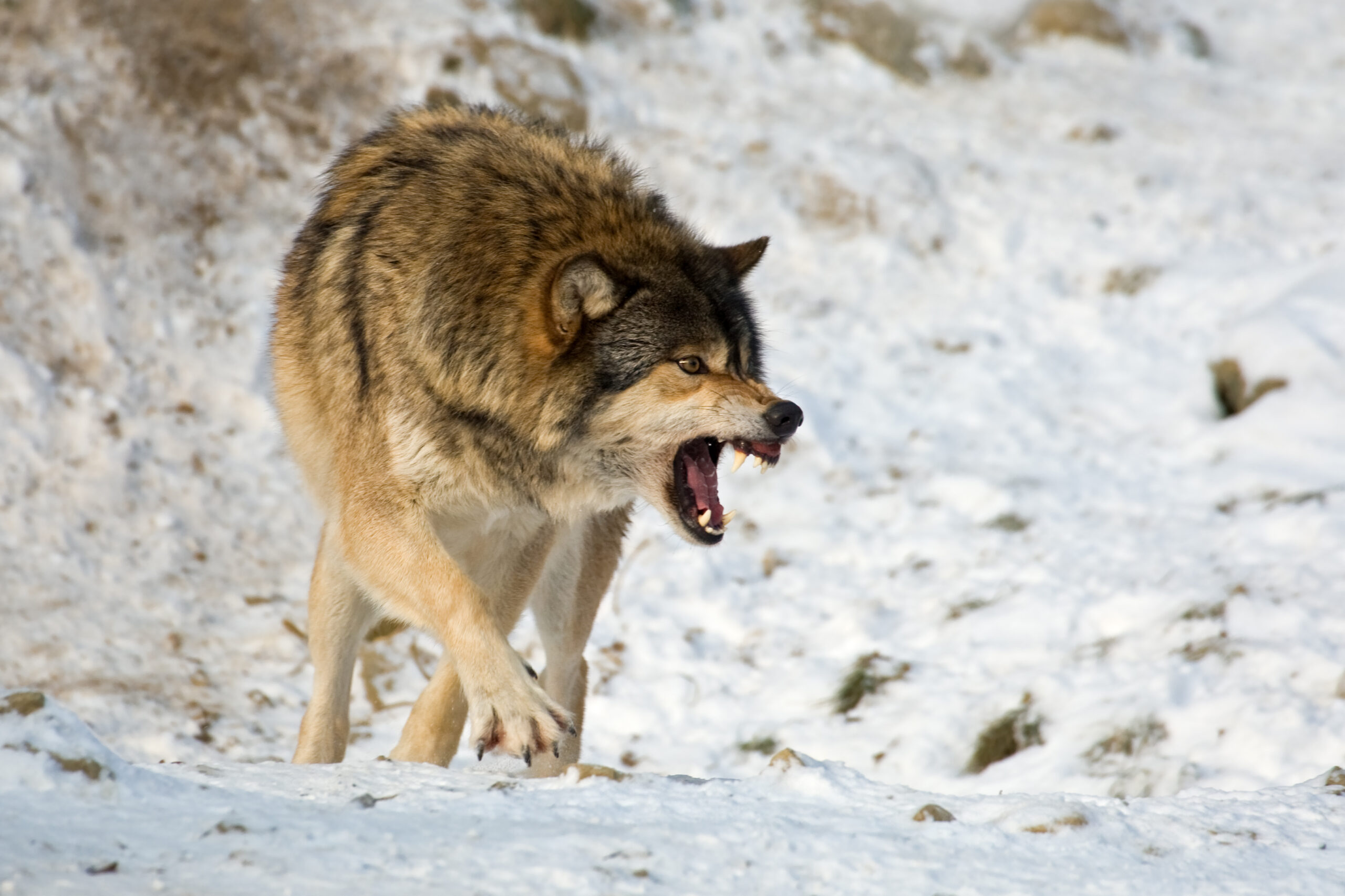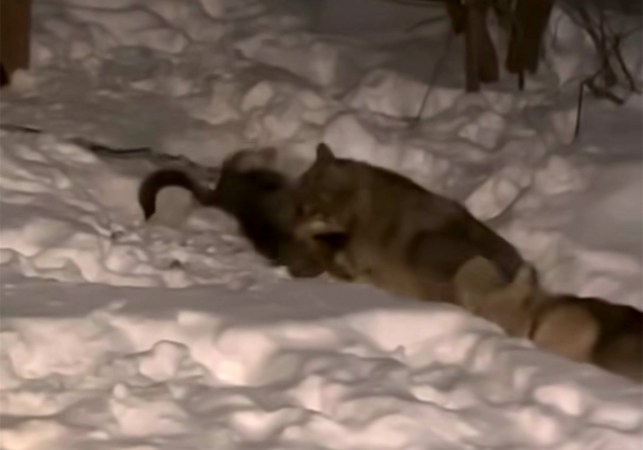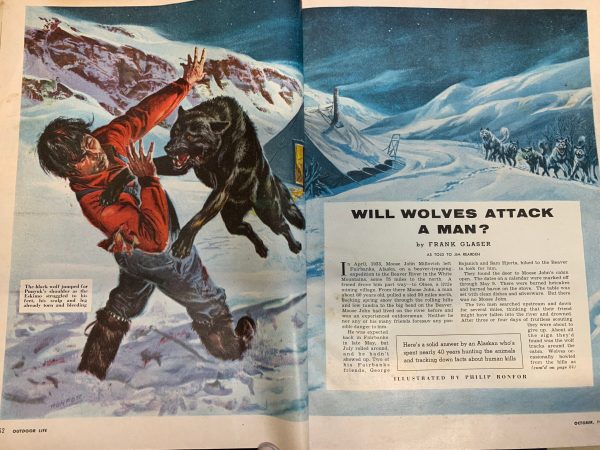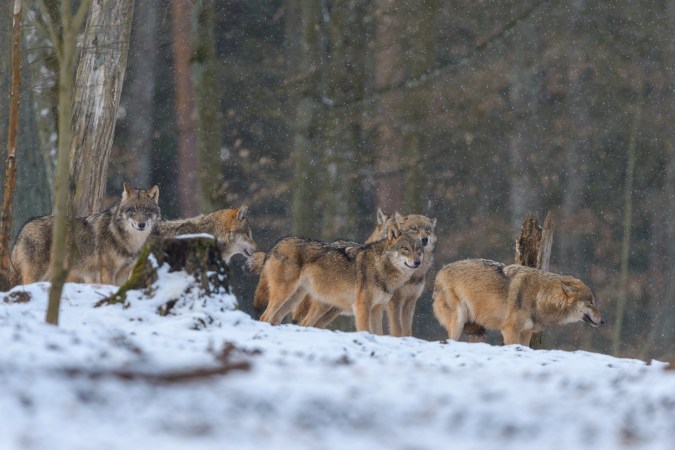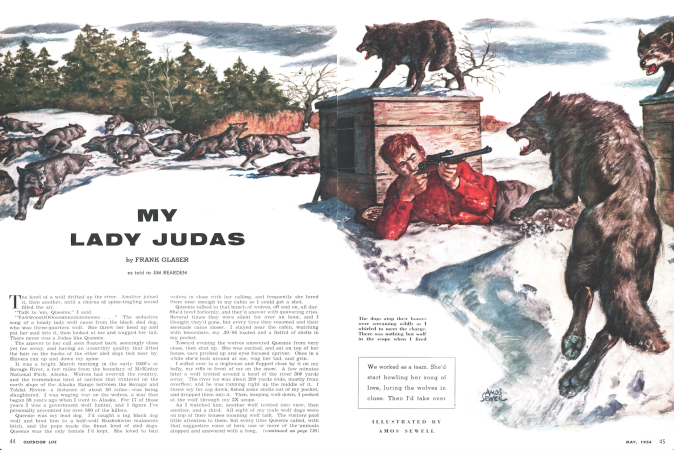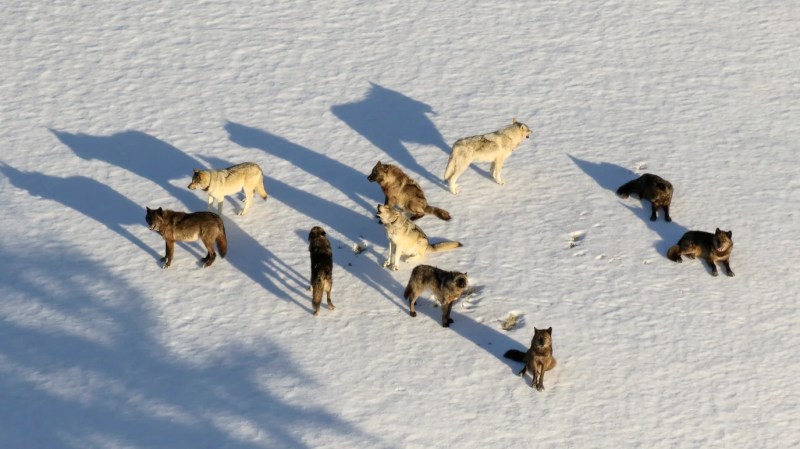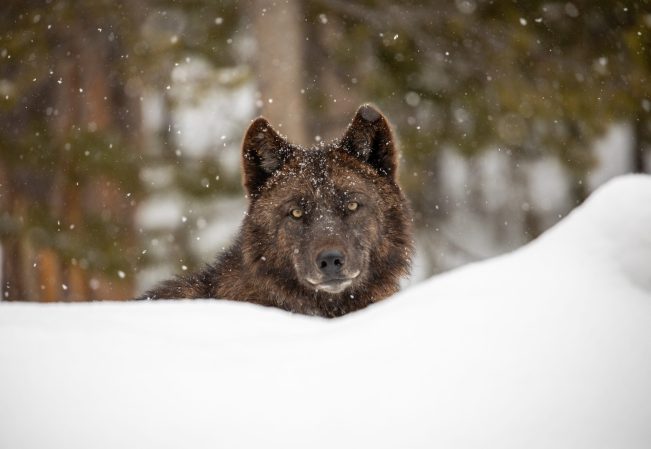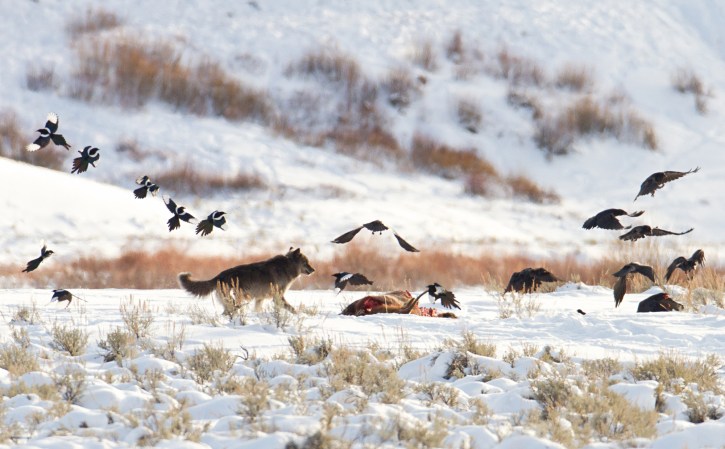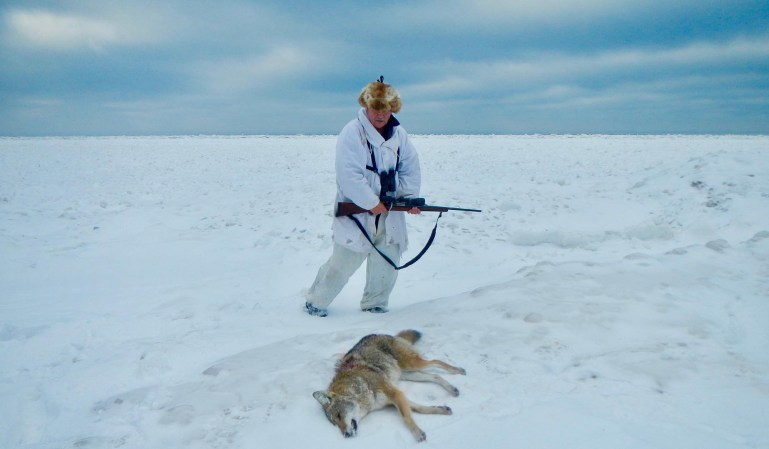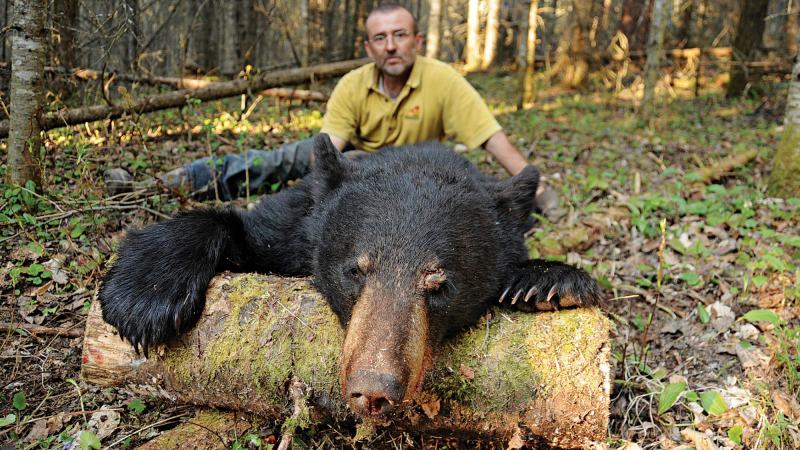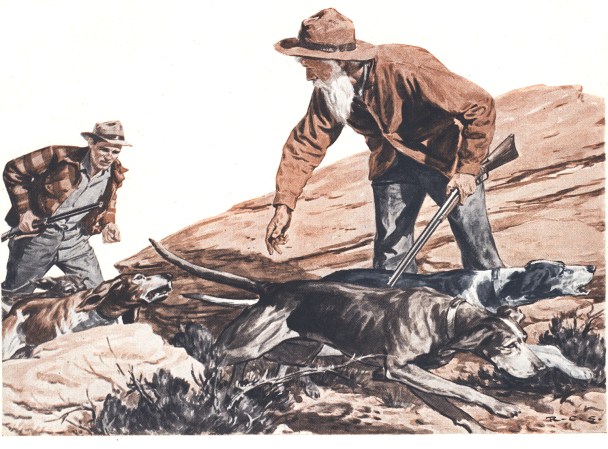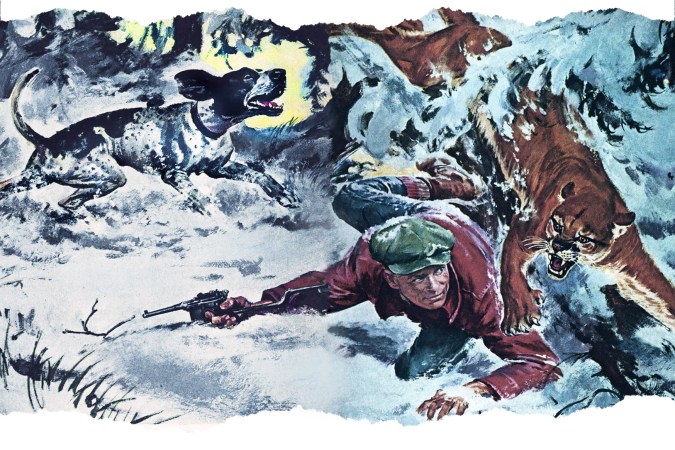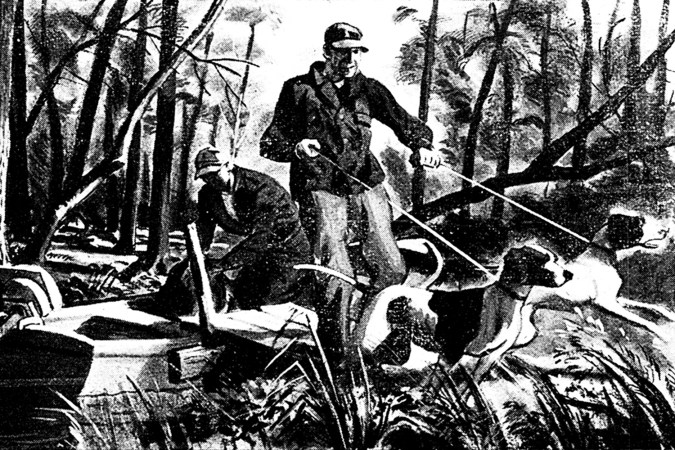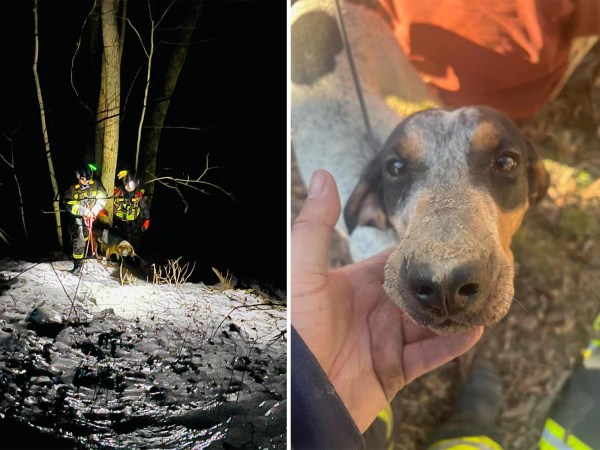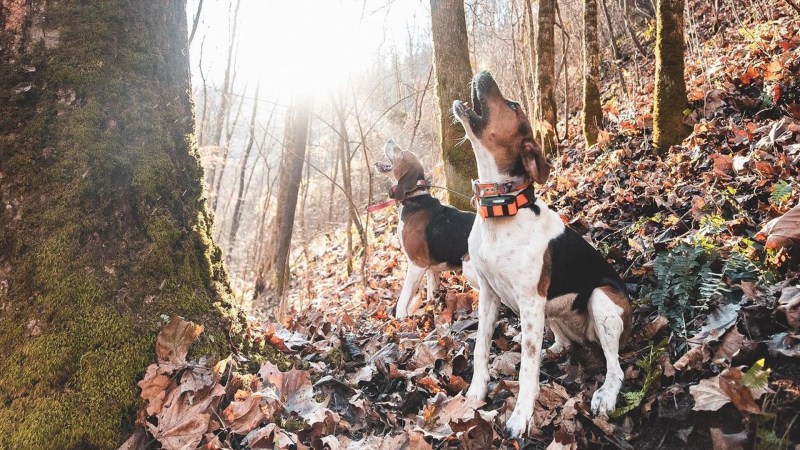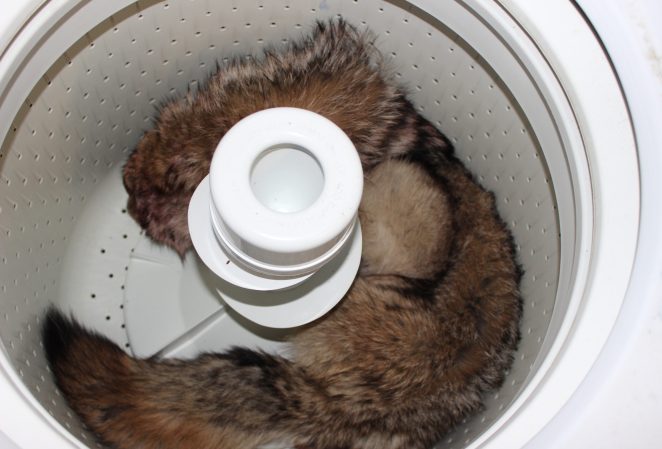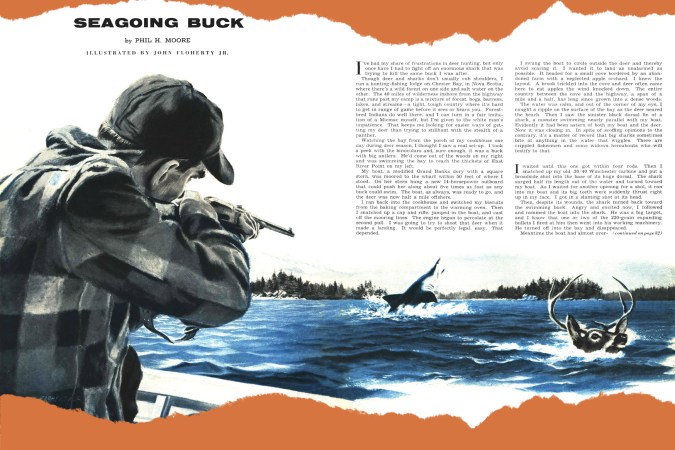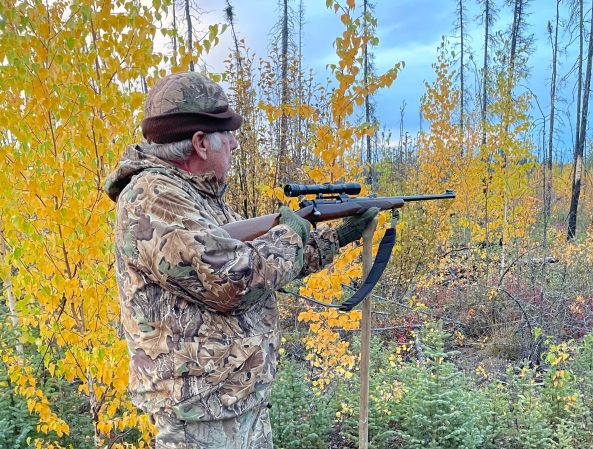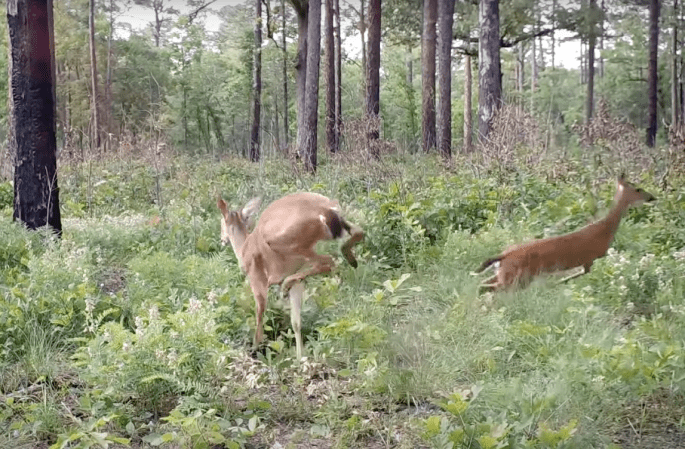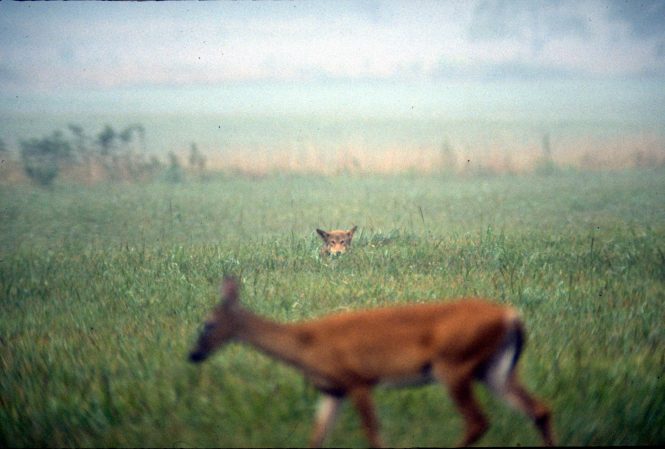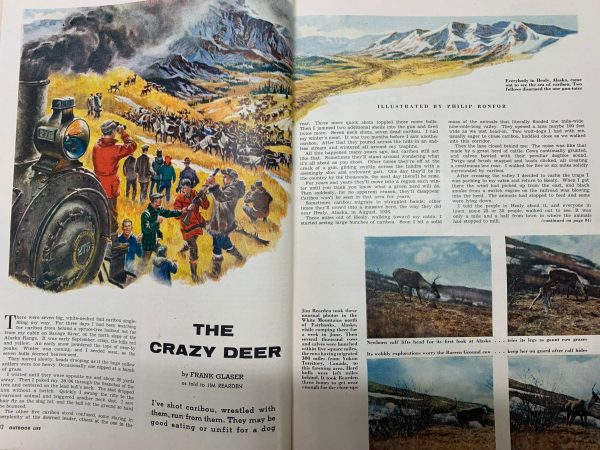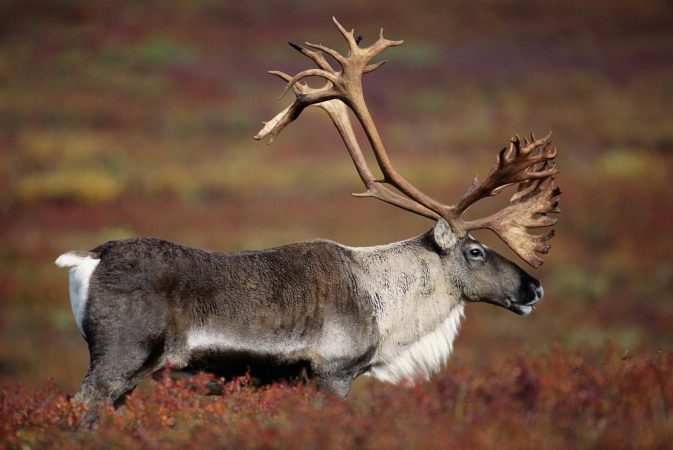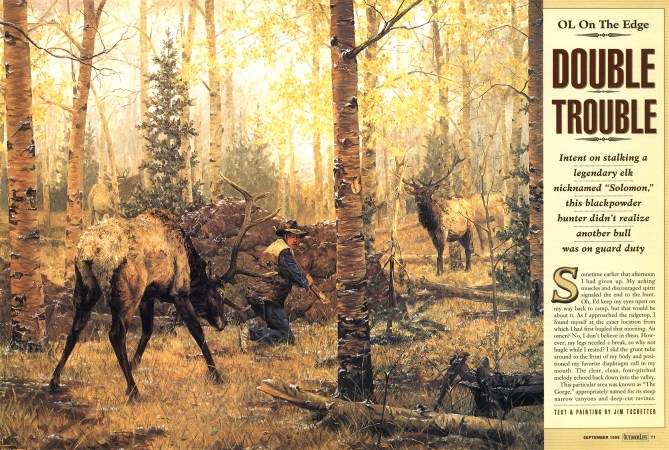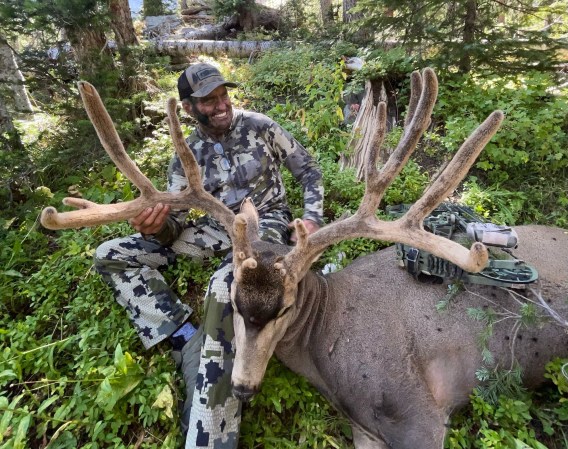Wolves killed a trailing dog in northern Wisconsin earlier this month, according to the state’s Department of Natural Resources. While wolf attacks don’t make headlines very often, close calls with aggressive wolves in the Upper Midwest seem to be happening more than usual.
Just ask five experienced outdoorsmen from Michigan’s Upper Peninsula who have encountered aggressive wolves at one point or another. Three of them were forced to climb trees to avoid being attacked, and one commented that he was going to start carrying a handgun as a result of the experience.
A variety of circumstances led to these encounters. Two men were training bear dogs at the time. (Wolf attacks aren’t uncommon in such scenarios, when dogs stray far from their owners to chase a bear trail.) Two more stumbled across wolf packs crowding around fresh deer kills. The fifth story comes from a dry lakebed, where Jim Paquette was looking for Indigenous artifacts when a wolf chased a deer past him. When the wolf saw the Paquette, it turned its attention to him instead.
All five outdoorsmen agreed that, since wolves are not a hunted species in the UP (even though they have surpassed recovery numbers), the predators have learned to not fear humans. These encounters happened over the course of several years, but the stories are still relevant to hunters headed for wolf country today.
Jordan Farmer: When Wolves Killed Duke
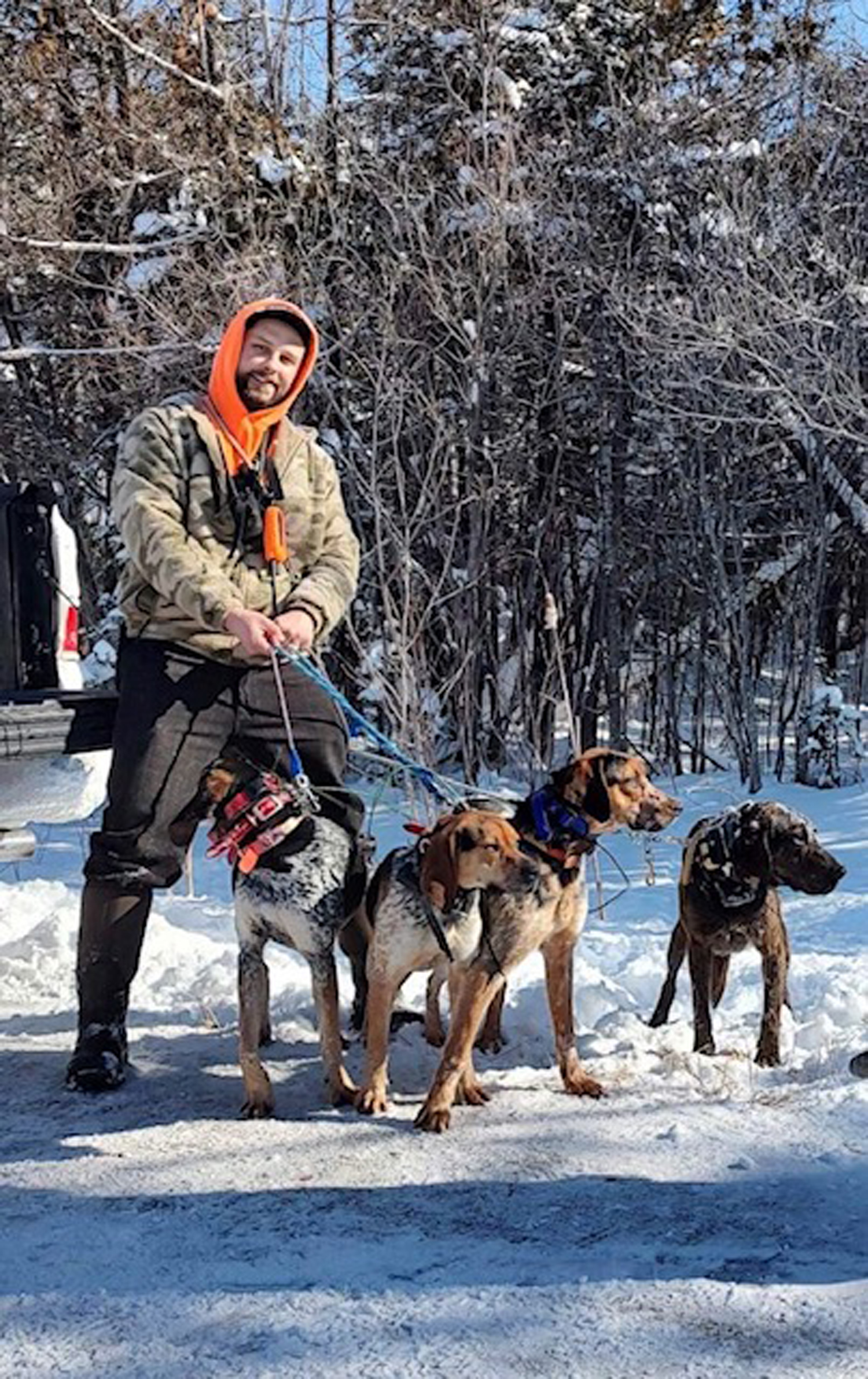
Avid hunter Jordan Farmer and his brother Justin were training their hounds for bear hunting in the Upper Peninsula. In Michigan, dog training season starts in July, long before hunting seasons start in September.
“Our dogs were running a bear when I noticed one of my young dogs (Duke) had stopped,” Jordan, an Upper Peninsula resident, says. “[He was] about six-tenths of a mile into a swamp. As I approached where my GPS showed him, I was greeted by two wolves eating the guts out of him.
“I yelled to scare the wolves off, but that only got their attention and then they approached me. As they came closer, I grabbed sticks and threw them at the wolves. When that did not scare them, I took a dog leash and started hitting trees and the ground with it. The wolves still came closer, getting within 10 to 15 feet from me.”
At that point, Farmer says that he climbed a nearby tree to avoid being attacked by the wolves. After the pack eventually left, Farmer climbed down to check on his dog. All that remained were its head and shoulders.
“This was the day I realized it is no longer safe to be in the woods unarmed, and that every time I release one of my dogs it may be the last time I see them alive,” Farmer says. “There is no safety in these woods anymore. I have been face-to-face with bear, bobcat, mountain lion, and every other animal in the woods, but I have never felt so scared of an animal until the day that I lost Duke.
“After incidents like these, we are told time and time again by the DNR to try and hunt where there are no wolves. Well, that is nowhere in the UP. The wolf has taken over every corner and crevice. There is no longer a piece of land you can go to escape the presence of wolves.”
Read Next: When Wolves Kill Man’s Best Friend
Darrell Jonet: Treed By Three Young Wolves
Darrell Jonet was also training his bear dogs when he was treed by wolves. Jonet’s dogs were on a bear’s trail when he heard wolves howling on the sides of a deep valley the hounds were in. Darrell immediately became concerned about the safety of his prized hunting dogs, so he ran toward where he last heard the hounds, hooting and hollering as he ran to call the dogs to him. At the same time, he was hoping the sounds he made would scare the wolves away.
In this case, the noise Jonet made had the opposite effect. The wolves honed in on it.
“I was in some hardwoods about 400 yards from the road when I saw the wolves running toward me about 80 yards away,” Jonet says. “They were coming right to me as though they were my dogs responding to my calls. They had to know I was a person. When they saw me, they kept coming.
“Not knowing what else to do, I found a tree and climbed it. Three wolves that looked like they were adolescents came right to the tree I was in and looked up at me. They were followed by an adult wolf that I think was a female.
“You could see a path through the ferns that I had made when running. The female turned and followed that path. Then an adult male arrived that had the hair up on his neck like he was agitated. He stayed back away from the tree and left after a short time.”
Jonet had his cell phone with him. He used it to call a fellow hound hunter for advice. The trio of young wolves remained at the base of the tree Jonet was in, listening to the conversation for about five minutes.
The wolves did not show any aggression by growling or snarling, but they did not show any fear either. It was strange behavior that frightened Jonet.
“I’ve spent my whole life in the woods and I’ve never been scared before,” he says. “Those wolves really scared me. There were some tense moments.”
The wolves eventually lost interest and wandered off. After they had been gone about five minutes, Jonet climbed down from the tree and slowly made his way back to his truck, keeping an eye out for trees he knew he could climb in case he had to do so again.
Rory Mattson: Stumbling Into a Wolf Kill
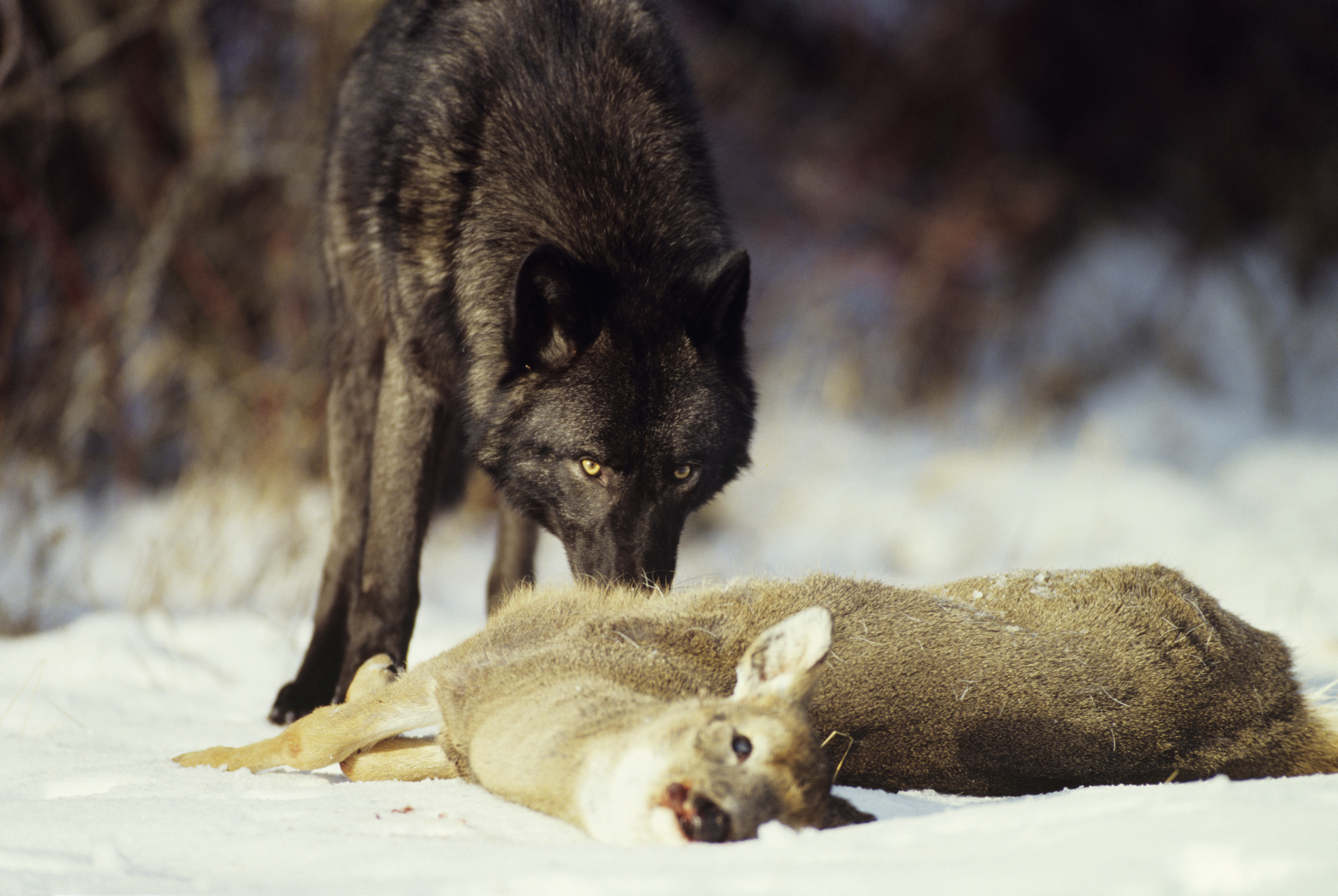
In early October, Delta County Conservation District forester Rory Mattson was walking along a new logging road to see if it needed any modifications. He saw wolf tracks in the road’s soft sand and thought it would be nice to see the animals that made those tracks. He got more than he bargained for when he came around a corner.
“The first thing I saw was blood all over,” Mattson said. “Then I noticed a good-sized doe with a wolf standing over it and another wolf nearby. They were in full growl and snarl mode.
“’Okay, they are going to protect this kill,’ I thought to myself, ‘so I am going to get out of here.’ I think I only backed up a couple of steps when I heard growling behind me. I turned around and there’s a big male 50 feet away. I’m guessing he would have weighed 140 to 150 pounds. He was standing in the road with a smaller wolf.”
Now, Mattson’s only option was to cut through the woods. Mattson was wearing a denim shirt that was unbuttoned with a tee shirt underneath. He extended the unbuttoned shirt to the sides to make himself look bigger and started yelling at the big wolf, but those actions had no effect.
As Mattson moved toward the woods, the wolf moved with him and even approached closer. Then Mattson saw some old sticks of pulpwood in the ditch next to the road that were 10 feet long. He lunged to grab one of the pieces of wood to use as a weapon. When he did that, the wolf closed the distance between them to about 15 feet.
Mattson waved the cumbersome piece of pulp between he and the wolf as best he could to try to keep the predator at bay as he backed up. When he backed into a balsam tree that was 16 inches in diameter that had limbs he knew he could climb, Mattson threw the wood toward the wolf and climbed the tree to a height of about 10 feet.
“When I looked down, the big wolf was at the base of the tree growling,” Mattson says. He didn’t stay there long though. He only stayed at the base of the tree for 30 seconds, then was gone. From the tree, I could see the wolf still standing over the deer carcass. It hadn’t moved the entire time.”
After about 30 minutes, it started to get dark. Not wanting to get ambushed in the dark, Mattson decided to head for his truck. He jumped to the ground, grabbed the stick of pulp and angled through the woods away from the kill to the road. When nothing followed him for 200 yards, he took off running for his truck and made it with no problem.
“I’m sure the aggressive behavior of the wolves was all about the kill,” Mattson says. “I noticed that they had eaten some of the deer, but I probably interrupted their meal. The doe hadn’t been dead long.
“I didn’t see any fear in the eyes of that adult male. He definitely was not afraid of me. Having that stick in my hands helped. Otherwise, he might have bit me.
“I’m going to carry my pistol with me from now on,” Mattson says. “If I would have had a gun with me at the time, I would have fired a warning shot to try to scare the wolf away. If that wouldn’t have worked, I would have shot him.”
Tim Olsen: Wolves After Dark
It was October 15 when Tim Olsen bumped into wolves on a fresh kill after dark. He had planned on bowhunting for deer that day, but heavy rain canceled those plans. When the rain let up after dark, he decided to check the card in the camera by his stand to see what deer had been there. After changing the card in the camera, Olsen made a wrong turn on the way back to his ATV.
“Wolves had a deer down in the 4-wheeler trail,” Olsen says. “As soon as my light hit them, they started growling and snapping their chops at me. I never thought I would make it out of there.”
Olsen saw three wolves. They were all lying down, feeding on the deer they killed. He said a white wolf was on the left, facing to the right. A calico-colored canine was on the right facing left and a “giant” black wolf was between the other two facing Olsen.
“I was hollering, swinging my arms and throwing branches at them to try to keep them away from me,” Olsen says. “At the same time, I was backing away from them. The black one kept trying to get on the right side of me. I think he was trying to get behind me.
“My biggest concern was to stay on my feet. If I would have fallen down, I would have been in real trouble. That was the most scared I’ve been in my life.”
Jim Paquette: Caught Up in a Deer Chase
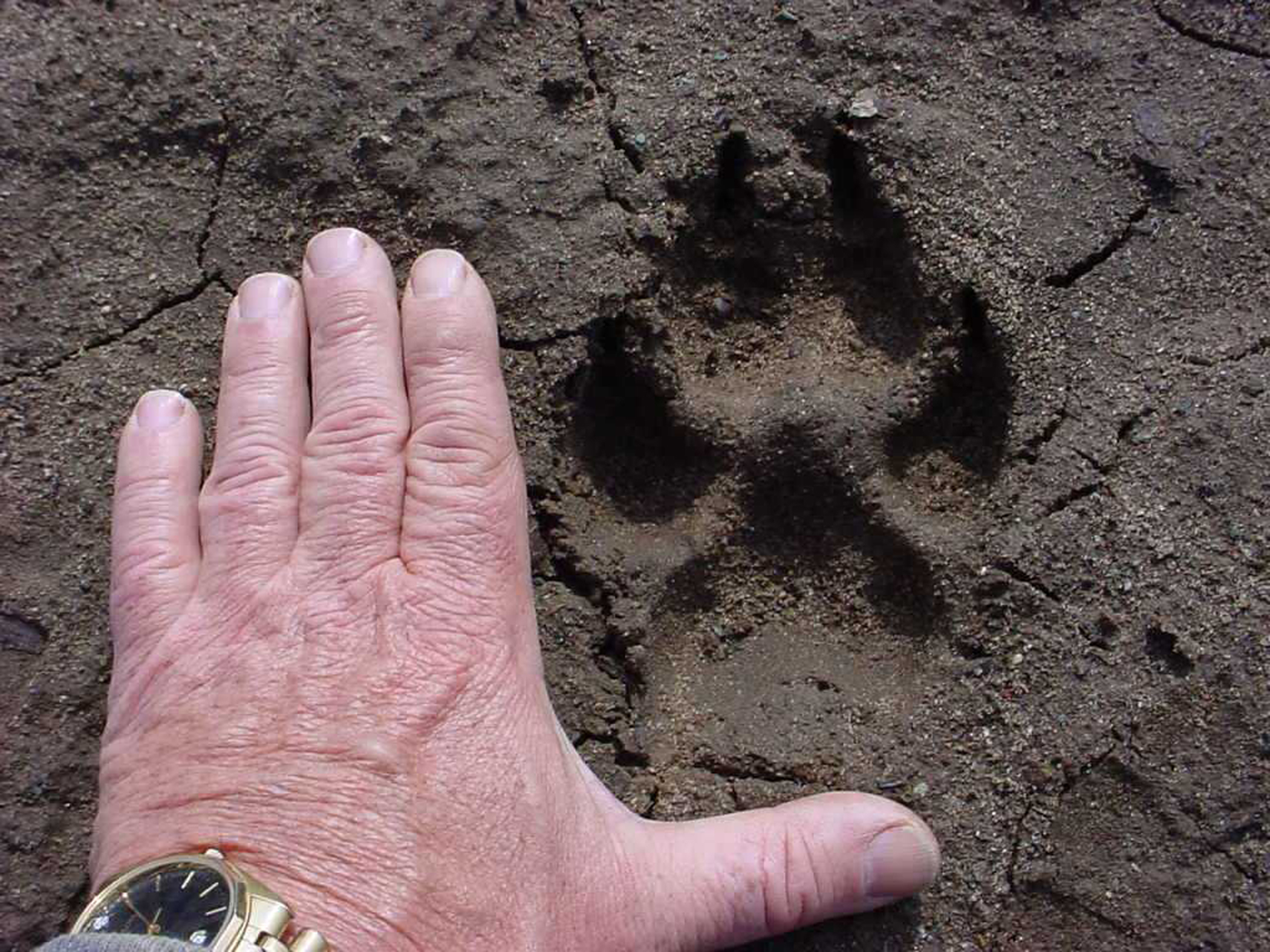
Jim Paquette was searching a dry lakebed for artifacts in early June when he saw wolf tracks chasing deer tracks. At one point, Paquette put his backpack down, leaned his walking stick against it and took out a digital camera to photograph tracks of the wolves. A short time later, a big doe suddenly appeared running from the woods right toward him. The whitetail was breathing heavily, with its mouth open and saliva streaming out of its mouth.
In spite of the fact that Paquette was standing in the open, the obviously stressed doe ran right by him. Based on the tracks Paquette saw, he figured the doe was being chased by wolves. Sure enough, a wolf soon appeared from the same place the deer had come from.
Realizing what a unique opportunity it was to see a wolf, Paquette took advantage of the opportunity to snap a photo of the predator. He wasn’t sure how long it would hang around after it saw him. The time stamp on that image after the wolf crossed the driftwood along the edge of the woods was 10:20 a.m.
To Paquette’s surprise, the wolf approached him. The animal was obviously in predator mode after chasing the deer. Paquette took a second photo of the wolf 16 seconds after the first.
“The wolf came right at me,” Paquette says. “He had his ears pinned back and he was looking right at me. Once I realized the wolf was coming at me, I thought about grabbing my walking stick. That was the only thing I had to protect myself from the wolf.
“The stick was leaning against my knapsack and I would have to move toward the wolf to get it, so that’s what I did. I ran toward the wolf to get the stick. That aggressive move on my part caused the wolf to change his actions. He started running parallel to me instead of continuing toward me.”
Paquette took a third photo of the wolf eight seconds after the second one, when it was paralleling him. Seconds later, the wolf charged directly at Paquette.
Read Next: Do Wolves Attack Humans?
“I started to scream at the top of my lungs and wave my arms wildly as it attacked,” Paquette says. “My screaming and aggressive arm motions stopped the wolf’s charge just as it approached within a matter of feet, and it then turned and ran back again.”
Paquette snapped a fourth photo of the wolf as it trotted away from him. The time stamp on that image was 10:21. At that point, the wolf clearly knew Paquette was not a deer.
“The wolf ran back some distance and began to walk back and forth pacing, all the time looking right at me. I took a fifth picture then. Suddenly, the wolf turned and charged me once again, coming at me at a trot. I started screaming and swearing and wildly waving my arms again. This time it stopped its charge a greater distance away.
“It then turned and trotted back toward the tree line, but it stopped on the beach and paced back and forth while looking directly at me. I then took the sixth and last photo, but I kept screaming and waving my arms trying to keep it from charging. Finally, it walked back over the driftwood and disappeared into the trees.”
